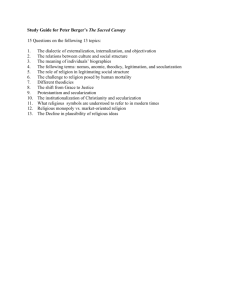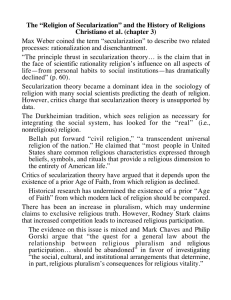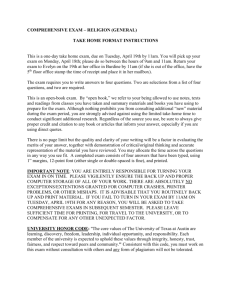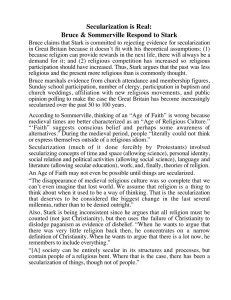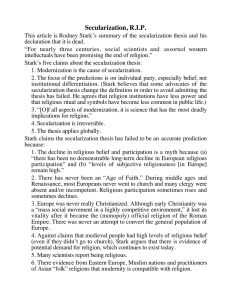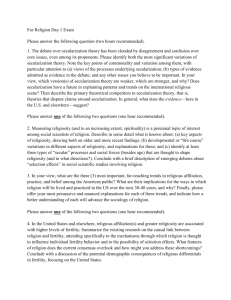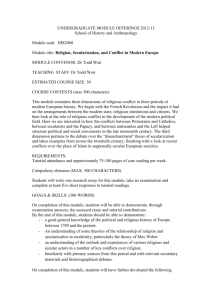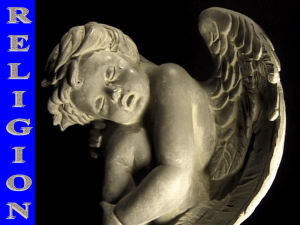I would like to begin with a story
advertisement
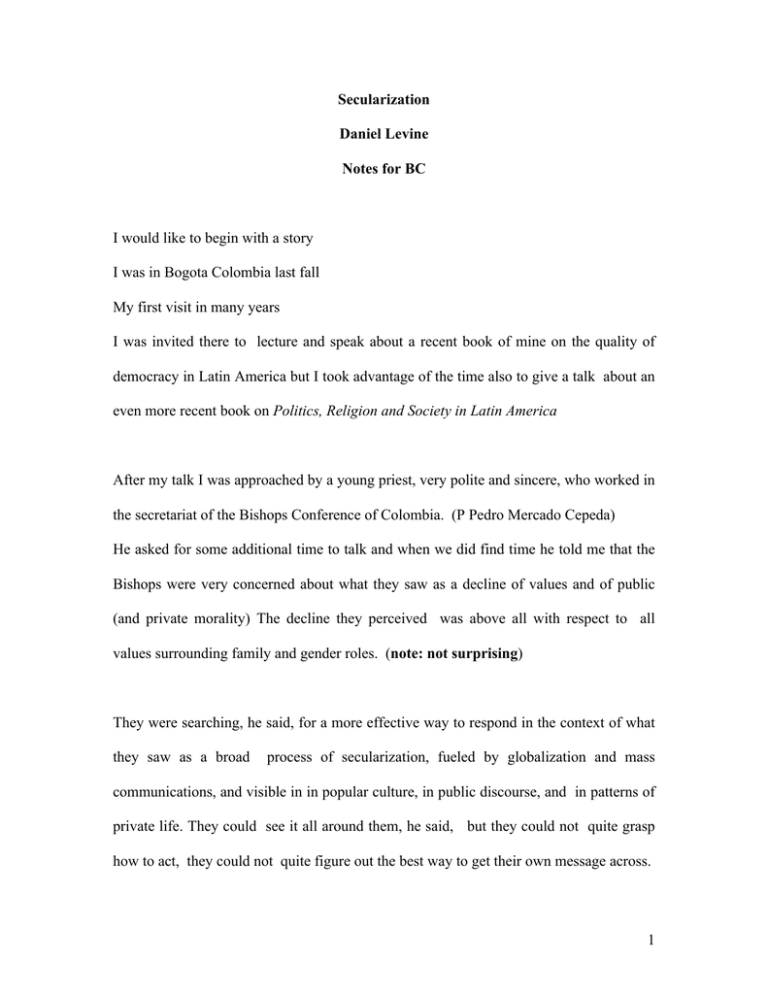
Secularization Daniel Levine Notes for BC I would like to begin with a story I was in Bogota Colombia last fall My first visit in many years I was invited there to lecture and speak about a recent book of mine on the quality of democracy in Latin America but I took advantage of the time also to give a talk about an even more recent book on Politics, Religion and Society in Latin America After my talk I was approached by a young priest, very polite and sincere, who worked in the secretariat of the Bishops Conference of Colombia. (P Pedro Mercado Cepeda) He asked for some additional time to talk and when we did find time he told me that the Bishops were very concerned about what they saw as a decline of values and of public (and private morality) The decline they perceived was above all with respect to all values surrounding family and gender roles. (note: not surprising) They were searching, he said, for a more effective way to respond in the context of what they saw as a broad process of secularization, fueled by globalization and mass communications, and visible in in popular culture, in public discourse, and in patterns of private life. They could see it all around them, he said, but they could not quite grasp how to act, they could not quite figure out the best way to get their own message across. 1 So I talked to him about three or four things First I pointed to the facts of religious pluralization and pluralism in the context of a more open and diverse civil society, a phenomenon visible everywhere in Latin America, even in reliably conservative countries (and churches ) like Colombia. These facts mean that the Catholic Church is, and if it is to be realistic, has to see itself now, as one actor among many. No longer THE church accustomed to issuing directives but one actor, an important and prestigious actor to be sure, but still one voice among many, whose statements and actions have to convince and commit people, people who have access to many voices , many sources of information, and many options I also talked with him about different ways to understand this process of secularization moving beyond conventional notions of secularization as an irreversible and inevitable process of the privatization and decline of religion. The model for this is, of course, the gradual but steady decline in religious beliefs, affiliations, and practices…of the kind that is well documented in Western Europe after WWII That is indeed the pattern for Western Europe but as others here will affirm, that may well be the exception, not the rule. In Latin America for example, where I have done most of my work, although there is a small but growing number (in each census) who report NO affiliation, the broader results show a surge in religious movements, many of them new, leading to a rearrangement of religious affiliations and identifications, and a renegotiation of the ways in which churches (all of them) situate themselves in the public sphere. 2 This reflects a kind of secularization with religious vitality (as Jose Casanova puts it) that takes strength from growing personal and group autonomy which is another dimension of secularization ----- The idea of personal and group autonomy to choose, to belong, to decide. I pointed out to him that in this light, many who consider themselves faithful Catholics could and did, in full and tranquil conscience, simply disregard directives from the hierarchy. They are, as my colleague Fortunato Mallimaci put is, Catholics in my own way, or on my own account (catolicos a mi manera o por cuenta propia) Mallimaci goes on to point out that in Argentina today, people don’t believe more or less. They believe in different ways What this means of course, is that traditional church strategies, now refurbished in many places under the title of “reconquering civil society” are unlikely to be effective, at least not in those terms. Operating by decree wont work as it did in the past, if indeed it ever did work as neatly as some think. There are just too many voices, too many arenas and spaces, not only in civil society generally, but also and importantly within the church—schools, universities, publications, artistic expressions, organizations, etc etc. What is required is coalition building, convincing people, building alliances across traditional divides This is already happening in much of Latin America on issues of sexuality and in particular on marriage equality, as well as on issues like rights, housing, or land just to name a few. 3 I also talked with him about the fear of the future that I saw in the process and documents of the most recent meeting of Latin America’s Catholic Bishops at Aparecida in 2007. The fear that is so prominent at Aparecida is not just about changing numbers, although that is one element. This fear is partly compounded of an older tradition that error has no place alongside truth, but more is at issue. The underlying concern is about control and fear of loss of control. Many church leaders seem to fear that faith is shallow and is likely to lose in competition with others unless it is buttressed by state support and extensive clerical advice, supervision, and control of the faithful. But as I have suggested, control of this kind is no longer very likely. So the alternatives are either to rethink secularization and the church’s approach to it, or to remain on the sidelines of an ongoing process, defending a position instead of entering the stream and working within it. This is not purely technical matter, say of using television more. It goes to the heart of how the church sees itself participating in ‘the world” , a world in which plurality and choice (not automatic membership and direction from above) are normal. This is also part of the meaning of secularization, The young priest was very polite, he said that it was all very interesting But somehow I doubt that he was very convinced or that any of these ideas would have much impact within the leadership of the Colombian church. ********** 4 In a similar vein, I was recently involved in a debate about secularization, on a religious discussion web site. The discussion took off from remarks by Donald Cardinal Wuerl, Archbishop of Washington DC. The text for debate was a statement by that the main problem confronting the church is Cardinal Wuerl the advance of secularism and secularization which he compared to a tsunami sweeping all before it, and taking with societal markers like marriage, family, shared concepts of the common good and objective right and wrong. In his view confronting secularization had to be a high priority for the new pope. Quote "Christianity is no longer a dominant culture, secularism is the dominant force in the world of culture. So the Holy Father is going to have to be a person whose focus will be on that." A few questions arise immediately. What precisely is secularization? What does secularization have to do with secularism? What does it mean for the church to “confront it” and why should this be a top priority? The discussion sparked a lot of comments, some of them personal accounts of Cardinal Wuerl and some more reflective of general issues in the evolution of church , but when I read through them all I found two things lacking. To begin with, a distinction should be made between secularism and secularization. They do not mean the same thing at all. The first, as historically embodied in French laicite, in the anti clerical laws that emerged from the Mexican Revolution, or for example in Uruguay or Turkey under Ataturk, can be seen as a militant commitment 5 to containing religion and above all limiting its place in the public sphere. Hence the attacks on religious place names, public recognition of religious holidays, or religious displays in public places. Secularization is quite distinct and as I suggested earlier, it is also varied. Secularization is in part an expectation of the decline, privatization, and disappearance of religion, not only as public figure but also as personal belief and practice. This theory has its roots in European experiences of struggle against entrenched church state alliances. Jose Casanova among others, has pointed out that this basic trio of characteristics (decline, privatization, disappearance) should be understood as empirical elements that can and do vary independently of one another. He and others have also underscored the great importance of institutional differentiation in this vision of secularization, a differentiation that separated church structures from those of the state and progressively removed privileges and functions from the churches. This is a familiar story. But there is more to say. As I suggested to my Colombian priest, secularization as a social process involves a lot more the decline and disappearance or religion, and certainly does not entail the necessary decline of morals. Anyway this is an empirical matter. Decline in the classic sense has indeed been the case in Europe, but not in the US or elsewhere. Secularization also has to do with plurality of options and plurality of belongings, with the idea of plurality (instead of the domination of THE church) as the new normal. This I take to be one of Charles Taylor’s central defining points about secularization Plurality of this kind carries with it a growing capacity (and growing demand) for autonomy on the 6 part of individuals and groups, autonomy in making choices, and making connections among the plurality of options out there. This autonomy means loss of control for church leaders, and that is what evidently exercises figures like Cardinal Wuerl and many others in the Catholic hierarchy. They equate loss of control with an inevitable decline of morals, secularization with elimination of standards of good behavior. But the idea that secularization brings moral decay is only valid if one assumes that moral norms can only come from one "authoritative" source. But there is no particular reason to believe this. The Gospels offer important norms but one would not want to say that Buddhists or Muslims or Hindus or Jews or members of any other faith, or non believers for that matter, are devoid of a moral compass What is really at issue here is fear is loss of control because without such control Cardinal Wuerl and those who agree with him have to operate in this plural environment as one among many. Hence the many, and absurd complaints from North American religious leaders about religious persecution in the United States. 7 NOTE 1 Froehle and Guatier point out that the current generation of Catholic bishops (most of whom were appointed by the Popes John Paul II and Benedict XVI) remains wedded to models in which state support is expected and guaranteed. In their words, (133) “these experiences poorly prepare European Catholicism [and the Catholic Church remains controlled by Europeans even if most of its members are found elsewhere] to understand religious pluralism. A ‘secular state’ in European experience, after all, typically meant an atheist state that re has secularized Church property and eliminate the Church’s voice in civil society. Conversely, a state that state that respects religion has often translated as a state that controls religion through restrictive legislation, tax policy, or patronage and financial largesse. Whether a carrot or stick approach, the concept of religion as a fully respected part of civil society outside state influence is not part of the European tradition….In an increasingly globalized and pluralistic world, Catholics may find that these long established European traditions are more the exception than the rule. “ (Froehle and Gautier, 2003, 133) Catholicism may remain among equals in Latin America, but in this view of the world, first loss of monopoly means loss in general. 8 Looked at from another angle, secularization considered as plurality and multiple autonomies offers opportunities as well as sources for concern. The opportunities are to reach all kinds of groups through a wide range of means in the multiple arenas that an open civil society and public sphere make available. As I told the young Colombian priest, in this kind of world, people, even people with great faith, are unlikely to respond with automatic obedience. They can be reached and perhaps convinced but a lot depends on the issue and the place. They are unlikely to be reached and convinced by campaigns that are mostly negative or, for example, by attacks on groups like the Leadership Conference of Women Religious in the United States, who in fact are doing the work of connecting to civil society. Something similar holds for the multiple efforts of the American Catholic bishops in the last few national elections.. With all due respect they seem to be operating with working model of society that is not very accurate. The church would be well advised to reconsider its understanding of society before launching into campaigns to counter secularizations Models of shepherds and sheep are not very adequate when dealing with educated informed mobile people. In more general terms, stress on boundaries and distinctions (the secular and the religious, the sacred and the profane) may reify analytical distinctions in ways that are not helpful when we come to address real behavior. These distinctions have meaning, of course, but in daily practice ordinary people blur these boundaries and join one element with another, without much difficulty or complex cogitation. Churches and church groups deal with states, religious individuals belong to trade unions or political parties AND churches, mosques temples or synagogues. People hear social and political messages all the time in 9 churches and they put church networks to work all the time addressing secular problems from food to housing, transport or safety. I always find the work of Nancy Ammerman to be instructive and she points out that although it pretends to be universal, the secularization story with which we are all familiar (decline privatization, disappearance) is really the particular story of particular groups of people. It is a story written by elites and intellectuals, a story composed from the perspective of the center. (and the European center at that) If we read history from a different angle, and listen at the margins, quite a different pattern emerges On the basis of her study of American congregations, she affirms that most ordinary people have “simply not learned the ideological lesson that if they believe in promoting social justice they should place less emphasis on witnessing, or—at the other pole—that if they believe in witnessing they should be wary of calls for social justice. They are perfectly willing to affirm that both social justice and evangelism are important, or perhaps that neither of those things is as important as a life of prayer, Bible study and high moral standards.” (Ammerman, 1996, 297) She goes on to point out that although secularization theory presumes a unique and definitive path to modernity there are other possibilities. “While modernist social theory took pains to relegate religious gatherings to the margins and to “private” social life, a newer paradigm can include religious communities as among the “publics” present in a complex society. Just as the either/or dichotomy of communal versus urban life is better described as both/and, so the either /or dichotomy of a single “common good’ versus 10 warring particularisms is better described as a both/and web of multiple publics collectively constituting the whole.” (Ammerman, 1996, 357) As part of preparing for this meeting I read and re read some of the more recent reflections on secularization by scholars including Charles Taylor, Jose Casanova, Alfred Stepan, Rajeev Bhargava, David Voas, Steve Bruce, Grace Davie, and by my colleague Ronald Inglehart. I want to offer brief comments on some of the ideas they lay out. Then I will conclude For Steve Bruce (2010) two elements are central to secularization: the loss of control by religious institutions and leaders in the public sphere, and a long term decline in practice, belief and belonging, “a slow process of generational change in which people gradually lose interest in things that mattered to their parents and in which the possibilities for belief and practice expand while the salience of any of those beliefs and practices declines “ (Bruce, 2010, 19) Bruce and Voas show in detail this is certainly the pattern for Europe—steady and consistent and affiliation, beginning inter generational decline in belief, practice in the early 2Oth century and accelerating strongly after World War II. Inglehart and Norris (2004) extend the argument world wide, with data that show a close relation between the decline of religiosity (belief, practice, affiliation) and the rise of what they call existential security. Richer, more educated and more secure nations are likely to be less religious, and richer, more educated and more secure individuals and groups within any nation are also likely to be less religious. The 11 continuing religiosity of the United States is explained with reference to high levels of inequality, and the authors account for the vigor of religion in much of the rest of the world by reference to demography and tradition. Higher birthrates in poorer and more religious countries, and religious tradition (often identified with nationality and language) limit the pace of religious decline in some areas, like the territories of Orthodox Christianity in Eastern Europe. For Inglehart, the Latin American situation is paradoxical. Latin Americans combine continued adherence to religious values along with growing demands for self expression and personal freedom. The paradox disappears if, as I have suggested, we take a view of secularization that allows for religious diversity precisely within a secularizing society. As I suggested earlier, what is under way in much of Latin America is not undifferentiated religious decline but something much more complex and interesting. A surge of religious innovation and diversification has developed in environments no longer dominated or controlled by religion, and certainly not by a church in the classical sense. Accelerated urbanization, education, and access to media together generate not so much an undifferentiated decline as a reorganization of relations with the churches and with religion as a set of norms, one that suggests patterns affiliation and obedience that are much less automatic than in the past. This is not secularization in the ordinary language sense of decline, privatization and ultimate irrelevance, but rather secularization in the sense of a greater autonomy of groups (contested, to be sure, but very present), an autonomy that changes the relation of individuals and groups to the churches, and alters 12 the stance that churches can assume and have in fact assumed in what is now a decidedly plural public space. To cite one more example, Grace Davie’s work affirms the notion of multiple secularization narratives (with Europe possibly being an outlier rather than a model). She also underscores the importance of control issues for the churches. Despite their continuing social presence, historic churches are losing their capacity to discipline the religious thinking of large sections of the population (especially among the young). She places this in the context of what is for religion, a turn from obligation to consumption. She also raises the question of the extent to which the residues of state church identities sustain the notion of religion as a public utility rather than a freely chosen voluntary activity. In the same way, Casanova underscores the fact that many of what we see as secularizing societies have developed multiple ways of sustaining and supporting religious practice from tax abatements to direct subsidies and symbolic alliances. So the question is more complicated than the idea of decline alone might suggest. Anyway, although general debates about secularization (in terms of rates of belief, practice and so on) are suggestive and the findings often powerful, they do not exhaust the questions of interest. We also want to know how people relate to the institutions of religion, and how these institutions, and the collection of groups and movements associated in some way with them, position themselves in public life. The transformations I have outlined here have direct bearing on the role churches as 13 organized groups, as institutions, play in the public sphere. They confirm that there will be multiple voices and multiple actors, in society and within the church itself, and that therefore an effort at the re conquest of public space by the churches is likely to fall short if not implode on itself. Recent empirical work by numerous Latin American scholars (Parker, 1996, 2005, 2009, Blancarte, 2009, Loaeza 2009, Mallimaci 2005, Mallimaci and Villa, 2007) affirms that the evolution of pluralism has altered the relations of religious believers to institutions. Although many continue to identify as Catholic, such an identification no longer translates (if it ever did) into automatic political adherence or social mobilization in support of policies articulated by Church leaders. Other religious groups, growing fast, may have more intense forms of membership (as they do elsewhere in the world) but they also may not command automatic obedience in the voting booth or in patterns of social life. One thinks of the phrase attributed to the founder of the Universal Church of the Reign of God in Brazil, to the effect that it is prohibited to prohibit!! As a general matter, the emergence of autonomous citizens and groups in a secularized and open milieu changes the ways in which politics is open to the churches, and raises serious doubts about the viability of ecclesiastical strategies founded on the idea of re conquering social and political space for religion. As I told the young Colombian priest, religious values and ideas are more likely to be served by persuasion in a competitive marketplace. For those wedded to the ideal of THE church as a unique source of norms and values, there are ironies in this situation. As Tocqueville recognized in the 1840s, it is 14 precisely where religions have been separated from other institutions (where no official faith exists) that religious practice has flourished and diversified the most. He recognized that the very effort to prolong the existence of Christendom did grave damage to institutional religion in Europe. “So long as religion derives its strength from sentiments, instincts, and passions which are reborn in like fashion in all periods of history,”, he wrote, “it can brave the assaults of time or at least can only be destroyed by another religion. But when a religion chooses to rely on the interest of the world, it becomes as fragile as all earthly powers. Alone it may hope for immortality; linked to ephemeral powers, it follows their fortunes and often falls together with the passions of the day sustaining them.” (Tocqueville, 1967, 298) The experience of the United States bears directly on this issue, and has long presented a puzzle to conventional theories of secularization. American society is modern, highly educated, urban and industrialized, with institutions, laws, and a high culture that are secular in tone and content. North American society was and remains both highly religious and highly pluralist, a combination that fits poorly with classic models of secularization. Rereading the theory of secularization from a perspective rooted in the history of the United States, Warner (1993) sees the American “paradox” of religious modernity as no paradox at all. The central thread running through U.S. history is not the decay of a previous religious-political unity, but rather a consistent pluralism reinforced by marked religious populism. As Nathan Hatch puts it in his book on the Democratization of American Christianity, “Following the long tradition of democratic Christianity in America, Fundamentalists and Pentecostals reject modernity as it is expressed in high culture, but remain stalwart defenders of modern attitudes as they build 15 popular constituencies with the most innovative techniques. They will not surrender to learned experts the right to think for themselves.” (Hatch, 1991, 219) ******************** There is a short section on secularization in a chapter of my recent book but the truth is that this is not a subject that ever engaged me very much. I am not a sociologist (much less a sociologist of religion) by training, and therefore I have never had to learn and unlearn the assumptions that made secularization appear to be inevitable, progressive, universal, and for many analysts, desirable. These assumptions never struck me as very compelling. Instead, I came to the study of religion through my interest in the social presence of ideas, and as a political scientist, through my enduring concern with power. From that perspective, the interesting questions have less to do with the separation of religion from other spheres of life, than with the creative syntheses continuously being invented and put into play around the world. These are further enhanced by changes that place religion outside the state, so that it no longer exercising power directly, but instead competes to wield influence in society. As I have stressed here, this is not properly understood simply a story of decline. . What it is is a story of adjusting to a world where plurality is normal. In that light it is essential to move the discussion beyond an obsession with laicite, laicidad, to one more focused on competition, and on the evolution of rules of coexistence—for example, what political scientist Alfred Stepan has termed the twin tolerations—a mutual creation of legitimate space so that religions can operate freely without impinging on the state and vice versa. In a similar way Barghava argues for a “principled distance” 16 between religion and politics. There are innumerable ways to achieve this, and even secular Europe (or the US) displays multiple forms of accommodation from tax relief to direct subsidy. This process is not well understood as a simple matter of progressive privatization, decline and ultimate disappearance of religion, repeated everywhere in more or less the same form. There are many ways in which this can be accomplished, and as numerous scholars have affirmed there are also multiple narratives and multiple dimensions of secularization. The conclusion that I reach from all this is has two or three basic elements. First, it is essential to distinguish secularization as a process (with all its ambiguities and multiple narratives) from secularism as a kind of public policy. Second, secularization is not reducible to a single and replicable process, everywhere the same. Third, secularization entails demands for personal and group autonomy. These can coexist with great religious vitality, but the ways in which individuals and groups relate to church leader and structures—and the way churches position themselves in public space--will necessarily be very different from what we find in traditional models of THE CHURCH. Finally, fears about secularization that are so often expressed by religious leaders may be exaggerated, or better misplaced. They might want to have more confidence in the informed judgment of believers 17
